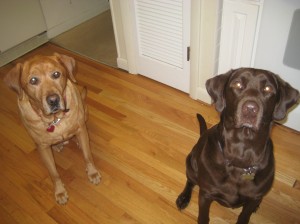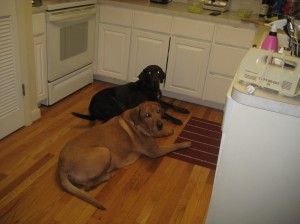I finished the book, “Through a Dog’s Eyes” by Jennifer L. Arnold; what I was most interested in was how she trained her dogs to be canine assistants in a humane and non-dominating manner. Ms. Arnold’s method rewards your dog for the requested behavior, if the behavior is not completed, they simply get no reward. This will require patience on your part, but you will be surprised how quickly they catch on.
Before you begin your training, think about the words you will want to use, have these set firmly in your mind, some commands require no real thinking such as sit. Others will require a bit of thought; I use “Off” when I want them to put all four of their feet on the floor; for instance if they are jumping up at something. I use “Down” when I want them to lie down; “OK” is the command I use to let them know they have been released from whatever they are doing and “Free Dog” when they can run off leash.
Your training sessions should not be too long; twenty minutes for an older dog and ten minutes for puppies. Work on one command at a time and take frequent breaks, as learning can be tiring. Perhaps a 30 second break every five or six commands. Sometimes it will take your dog some time to digest what exactly you are teaching; if your dog does not respond immediately, don’t keep repeating the command, instead give the command, mentally count to five and then repeat the command. Don’t become discouraged if they do not immediately “get” what it is you want; this will come over time. If you have tried a few times with no success, go back to a command they know well, you will want to end your training session with the dog feeling successful.
I started teaching the dogs “Watch Me” a good basic command to get your dog focused on you. I also like to use hand signals (or nonverbal) combined with my spoken commands, how I did this was I took the treat in my hand and said “Watch Me” and I raised the treat up between my eyes (believe it or not both dogs sat). As soon as both dog’s eyes were focused on me, I said “YES” “Good Job!” Once I’m sure they know the command, I can begin treating less frequently.
Sit is easy to teach puppies, you put the treat in front of their little nose,say “Sit” and then raise the treat up over their head, when they lift their head to follow the smell of the treat, their little butt automatically sits. While they are in the process of sitting you can say, “That’s Right” or “Yes” as soon as the butt is sitting, “Good Job” or whatever words you choose to use for your dog, then give the reward and the release command, “OK!” I usually rub them with my hand after I have released them so they know how pleased I am.
I use a closed fist for “Sit.” So I say, “Sit” and I hold my closed fist out. I like the non-verbal command for emergency situations. Let’s say, your dog wanders out of your yard and is across the street, your dog sees you and begins to make a beeline for you; but a truck is coming and your dog cannot hear your shout; the closed fist says “Sit.” If your dog has learned well, your dog will sit, saving your dog from certain harm, possible death and saving you from unthinkable heartbreak.
My dogs are big foodies and are always around when I am cooking or eating, so I figure if they are going to be in my kitchen, and I am going to reward them, then they should sit or lie down while I go about my business. Monday night I was using pieces of apple to show Chet how Delilah was doing with the “Watch Me” command. This morning I was using small bits of honey-dew melon, they also like carrots, watermelon, and pineapple among other things. I will use what is available to me and save the really good meat treats for when we are out on the trail.




Recent Comments